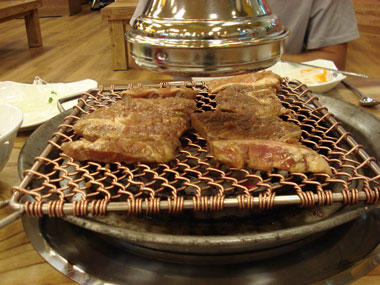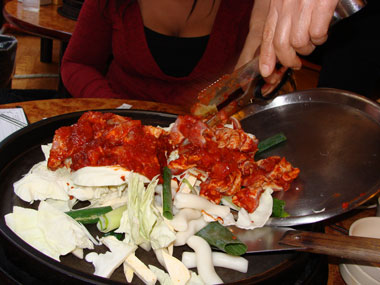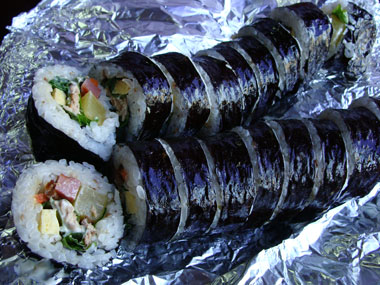Korean food is as adventurous as the land and culture it comes from. Mountains of side dishes, paired with a sensory overload that is typical of Korean dining and you have yourself an experience, not just a meal. In fact, dining on Korean is a bite full of the complex culture; fire and ice, spice and bland, a yin and yang all heaping with generosity.
Being a relatively unknown cuisine outside the Korean peninsula, here is a quick and easy guide that will clue you in on five of the most popular dishes you will encounter while eating Korean. Grab a glass of the notorious Korean alcohol soju, nibble on the kimchi already at your table, sit back, and enjoy your meal.
1 – Gogi, Galbi, and Sam gyeop sal (고기, 갈비, and 삼겹살)
 ‘Meat, Meat, and Meat.’ More specifically, ‘Meat, Rib meat, and Bacon’. These three items provide the basic menu for the well known ‘grill at your table’ style of Korean barbeque restaurants. Gogi and Galbi are not animal specific so adding a Dway gee (pork) or So (beef) prefix will make you look like a seasoned veteran in the eyes of your waitress. Sam gyeop sal, on the other hand, is specifically thick cuts of bacon.
‘Meat, Meat, and Meat.’ More specifically, ‘Meat, Rib meat, and Bacon’. These three items provide the basic menu for the well known ‘grill at your table’ style of Korean barbeque restaurants. Gogi and Galbi are not animal specific so adding a Dway gee (pork) or So (beef) prefix will make you look like a seasoned veteran in the eyes of your waitress. Sam gyeop sal, on the other hand, is specifically thick cuts of bacon.
Appearing out of nowhere, a restaurant worker will come waltzing through the crowded aisles toting a red-hot basket of fire. He will certainly take in stride the many near miss third degree burns on his way to your table. He’ll toss it into the void in front of you and slap a grilling grate over the top just as the plate of raw meat arrives. This is where the fun starts.
Once you put the meat on the grill, be attentive with the flips. Halfway through cooking, take the scissors and snip them into bite sized pieces. Feel free to toss any garlic on the grill as it will come in handy later. Don’t be offended if anyone from the restaurant yanks the tongs out of your hand to help, keep in mind, it’s for the good of the meal.
When finished, it’s time to make a baby grilled meat sandwich. Grab a piece of lettuce (삼 sam) in your hand, flavor with a bit of the side dish items and grilled garlic. Then, chopstick a small piece of meat from the grill, and place it on top of your little pile. Bring the edges of the lettuce together and it’s all ready for you. Nearly always too big for your mouth, there’s no graceful way to eat it, but part of the fun is shoving it all in there.
Don’t be intimidated by the perceived ‘rules’ of eating Korean barbeque that you may have heard. The bottom line is, it’s fun to cook, and incredible to eat. Entertaining and delicious, is there anything better than that?
2 – Bi Bim Bop (비빔밥)
 A simple dish with humble origins, Bi bim bob translates to ‘mixed rice.’ Ordering this, I always picture an old housewife cleaning her refrigerator of leftovers, throwing them in a bowl with some fresh cooked rice, and passing it off as a new and visionary recipe. It’s a bit more complicated than that, but you get the idea.
A simple dish with humble origins, Bi bim bob translates to ‘mixed rice.’ Ordering this, I always picture an old housewife cleaning her refrigerator of leftovers, throwing them in a bowl with some fresh cooked rice, and passing it off as a new and visionary recipe. It’s a bit more complicated than that, but you get the idea.
Start with a big metal bowl lined with a liberal amount of rice on the bottom. While staying true to our housewife, decoratively piled on top of the rice are bean sprouts, carrots, mushrooms, and cucumber spears. Underneath an egg topping is a dollop of red chili paste; be careful here, this stuff is fairly potent. Garnished with some kim it’s ready to eat. Simply grab a spoon, mix well, and enjoy.
If you happen to get served your Bi bim bop in a sizzling, thick stone bowl, no problem, that’s the variation called ‘Dolsot’ Bi bim bob. This dish requires one extra, and necessary, step to cook the raw egg sittings atop your meal. With your spoon, steer the egg towards the bowl and you will instantly hear the sizzle akin to your favorite breakfast joint back home. It will only take seconds to fully cook. Just watch your fingers and take some time for it to cool down before you dig in.
3 – Nang myeon (냉면)
 A baseball made of noodles, a bowl full of ice water, and scissors. These are not an exercise in free association; this is what you will get ordering the dish, Nang myeon. As odd as that combination may sound, this is a sneaky-good dish.
A baseball made of noodles, a bowl full of ice water, and scissors. These are not an exercise in free association; this is what you will get ordering the dish, Nang myeon. As odd as that combination may sound, this is a sneaky-good dish.
In a huge metal bowl of ice water, you will find a baseball-sized glob of green buckwheat noodles under some cucumber slices and a hard boiled egg. Yes, in the ice water. The waitress will hand you scissors along with two containers to flavor the broth, vinegar and spicy brown mustard. First, slice the ball of noodles a few times to make the eating process a bit easier.
Now, mind the potent condiments, these can make or break a quality bowl of nang myeon. Too much of the mustard with the mandatory red pepper paste already in the bowl, and your mouth could spontaneously combust. On the other hand, not enough and you have a bland bowl of ice cubes and cold noodles. ‘Add to taste’ is the mantra here.
Once that is accomplished, slosh the thin, slippery little noodles around the ice water and dig in. Don’t be embarrassed while eating them, they require massive slurps in the process, so don’t hold back, it’s part of the experience.
4 – Dalk galbi (닭갈비)
 Don’t forget to put on your complementary apron; you’ll be grilling up a mountain of goodies when you order this. If you find yourself anywhere near Chuncheon, South Korea, you won’t want to pass up Dalk galbi, the town is famous for it, and deservedly so, it’s the best around.
Don’t forget to put on your complementary apron; you’ll be grilling up a mountain of goodies when you order this. If you find yourself anywhere near Chuncheon, South Korea, you won’t want to pass up Dalk galbi, the town is famous for it, and deservedly so, it’s the best around.
A massive bucket of chicken meat drenched in red pepper sauce, cabbage, sweet potato, scallions, and tube-shaped rice cakes will all be dumped onto something that resembles an upside down trashcan lid sitting on top of your table’s grill. Be attentive once the waitress turns up the heat, the thick sauce has a tendency bubble up and hit anything in range that is the color white, hence, the aprons.
The potatoes and rice cakes will be done first, so if you can’t possibly stand the wonderful aroma tempting you from your grill, which is often the case, reach for these first; they will hold you over until the chicken catches up.
Before diving in, it’s important to make sure the chicken is cooked. If so, follow the same protocol as the typical barbeque (see #1 above), or pick and choose right off the hot plate. No doubt, you will instantly fall for the spicy, gooey, and beautifully crafted mess that is Dalk galbi.
5 – Kim bob (김밥)
 At first sight, the flavors of fresh sushi rolls and saki will pop into your head. Like with so much else in Korea, not so fast. Kimbob can be pronounced anywhere from kimbop to gimpop, and literally translates to ‘seaweed rice.’ Lucky for you, it has evolved to become one of the most popular snacks and appetizers around.
At first sight, the flavors of fresh sushi rolls and saki will pop into your head. Like with so much else in Korea, not so fast. Kimbob can be pronounced anywhere from kimbop to gimpop, and literally translates to ‘seaweed rice.’ Lucky for you, it has evolved to become one of the most popular snacks and appetizers around.
A thin seaweed square, the kim, starts underneath a generous serving of rice. Then layered on top are spears of radish, ham, and carrots. It’s rolled up and sliced sushi style, usually partnered with a small helping of pickled radish slices. I recommend choosing either the tuna (jom chi), cheese (jee sa), or kimchi version of the roll. All are very delicious, satisfying, and quick.
The ubiquitous kimbob is a food of convenience for Koreans, especially when enjoying the outdoors. Besides nearly every street corner, you can find people munching on this while mountain climbing, picnicking, or even in full gear on the bottom of the ski hills.
All photos by Jon Wick